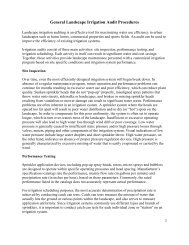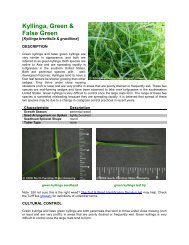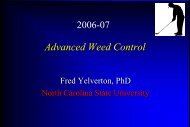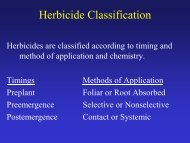Carolina Athletic Fields: - TurfFiles - North Carolina State University
Carolina Athletic Fields: - TurfFiles - North Carolina State University
Carolina Athletic Fields: - TurfFiles - North Carolina State University
- No tags were found...
Create successful ePaper yourself
Turn your PDF publications into a flip-book with our unique Google optimized e-Paper software.
<strong>Carolina</strong> <strong>Athletic</strong> <strong>Fields</strong>: A Guide to Maintaining Quality Turf on <strong>Athletic</strong> <strong>Fields</strong>the absence of rainfall, most sports fields require 1- to1½-inches of water per week during peak summer timeuse. In general, deeper and less frequent irrigation encouragesthe deep rooting and plant health that enablesturfgrasses to withstand stresses, including stresses ofplay. Ideal time to irrigate is in the early morning hours.A soil probe should be used to monitor soil moisturedepth and uniformity.MANTAINING AN ESTABLISHED FIELDIrrigatingImproper irrigation results in wasted water, added cost,and unhealthy plants. An irrigation water managementprogram is available online through the NC <strong>State</strong> Turf-Files website: http://www.turffiles.ncsu.edu/tims/. Generalwatering recommendations include the following:1. Water in early morning if possible. This is the preferredtime to water because it reduces the risk ofdisease, water loss through evaporation, and improperwater distribution. Also, the demand for water byindustry and municipalities is usually low at this time.2. Water established fields to a depth of 6 to 8 inches toencourage deep rooting. Usually, 1 inch of water perweek is adequate. Ideally, this would not be appliedin one application. Applying 0.5 inch of water everythree to four days is adequate for most situations.3. Use cans or a rain gauge to determine how muchwater is being delivered in a certain period of time.It takes 640 gallons of water to apply 1 inch of waterper 1,000 sq. ft. Because clay soils accept water slowly,water should be measured to prevent wasteful runoff.Water clay soils until runoff is about to occur. Wait 30minutes for the water to be absorbed. Then apply morewater until the desired depth or amount is achieved.This same technique can be used on compacted soils.Adjust any automatic irrigation system to supplementrainfall so that the field is not over-watered. Use a rainshut-off device on your irrigation system.Take certain precautions if you do not plan to irrigatethroughout the summer. Slowly ease a lush, activelygrowing field into dormancy. This can be accomplishedby allowing the drought stress symptoms to appearbetween infrequent irrigation cycles, by mowing high,and by not over-fertilizing with nitrogen. Brown, witheredleaves are normal signs of dormancy, so do not bealarmed by them. If the field is conditioned for this stressand has a reasonable level of maintenance, it shouldsurvive without permanent damage. Most turfgrasses canwithstand 3 to 6 weeks (or longer) without rainwater orirrigation and exhibit minimal or no damage, dependingon the situation. In the absence of rain, water dormantfields with a minimal amount (about 0.25 inch) everythree weeks to keep the growing points hydrated.MowingBermudagrass performs best when mowed at 0.5 to 1inch using a reel mower. However, good performance canbe achieved with a rotary mower with sharp blades setas low as possible without scalping. Uneven ground canmake mowing below 1 inch difficult. For this reason, a 1-to 1.75-inch mowing height is recommended when usinga rotary mower. For best results, bermudagrass should bemowed often (at least twice per week), especially at thelower mowing heights.1. Keep the mower blades sharp and balanced. Thecleanest cut and best mowing are obtained when themower blades are sharp. Dull mower blades reduceturf quality by tearing instead of cleanly cutting thegrass. Tearing creates many ragged leaf ends thatquickly wither and bleach and are easy ports of entryfor disease. Using a sharp mower is especially importantfor a high-quality athletic field. A properlysharpened and balanced mower blade will also reducemower vibration, lengthen mower life, and reducefuel consumption by as much as 22 percent.2. Mow at the proper height. The frequency of mowingis governed by the desired grass height and by theamount of growth, which depends on temperature,fertility, moisture conditions, season, and the naturalgrowth rate of the grass. In most instances, thismay amount to twice weekly and weekly mowing.To maintain a high-quality field, turfgrass should becut often enough that less than 33 percent of the leafsurface is removed with each mowing. If the turf getstoo high during wet seasons, raise the mower andcut off a fourth to a half of the present growth. Thenlower the mower to its proper height and mow againin a day or two.3. Leave clippings to decompose when they are short.Clippings that remain on the field quickly decomposeand release valuable nutrients and can reducefertilizer use by 20 to 30 percent. If clippings becomeexcessive, they may need to be removed. In somecases, removal is preferred before game-preparationpractices, like lining a football field.FertilizingSoil should be tested at least every two to three years todetermine the amounts of lime, phosphorus, and potas-10
















